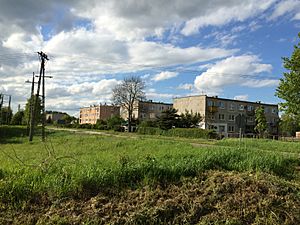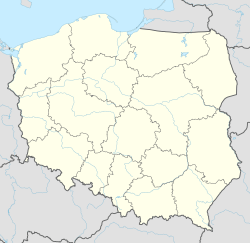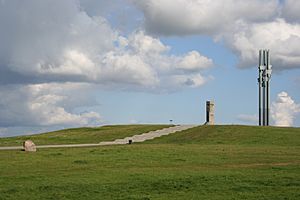Grunwald facts for kids
Quick facts for kids
Grunwald
|
|
|---|---|
|
Village
|
|
 |
|
| Country | |
| Voivodeship | Warmian-Masurian |
| County | Ostróda |
| Gmina | Grunwald |
| Population
(2011)
|
417 |
| Time zone | UTC+1 (CET) |
| • Summer (DST) | UTC+2 (CEST) |
| Postal code |
14-110
|
| Area code(s) | +48 89 |
| Vehicle registration | NOS |
Grunwald is a small village in northern Poland. It is located in the Warmian-Masurian Voivodeship, which is like a large region or state. The village is about 26 kilometers (16 miles) south of a town called Ostróda. Grunwald is famous for a very important battle that happened here many centuries ago. Today, about 417 people live in this historic village.
Contents
Grunwald: A Place of History
Grunwald is a quiet village today, but it holds a big place in history. It is part of a historic area called Masuria. The village's name comes from German, meaning "green field." This name is fitting, as the area is known for its green landscapes.
The Famous Battle of Grunwald
The most important event connected to Grunwald is the Battle of Grunwald. This huge battle took place on July 15, 1410, right near the village. It was one of the largest battles fought in medieval Europe.
- Who fought? The battle was between the combined forces of Poland and Lithuania, led by King Władysław II Jagiełło, and the Teutonic Knights. The Teutonic Knights were a powerful religious and military group.
- What happened? The Polish-Lithuanian forces won a great victory. This win was very important for both Poland and Lithuania. It changed the balance of power in the region.
- Why is it remembered? The Battle of Grunwald is seen as one of the most significant victories in the history of both Poland and Lithuania.
Today, the battlefield is recognized as a Historic Monument of Poland. Every year, on the anniversary of the battle, people gather for special events. These events include battle reenactments, where people dress up and act out the battle.
What Happened After the Battle?
After the big victory, King Władysław II Jagiełło wanted to build a chapel on the battlefield. However, the area remained under the control of the Teutonic Knights for a long time, even though it was later under Polish rule. The Knights built a chapel dedicated to Mary instead.
The village was first mentioned in old Latin writings from the 1400s as Grunenvelt. A famous Polish historian, Jan Długosz, used the Polish name Grunwald. This name has been used in Polish history books ever since.
Grunwald in Modern Times
After World War II, which ended in 1945, Grunwald became part of Poland. This happened because of an agreement made by different countries called the Potsdam Agreement.
Today, you can visit a museum and a special memorial site on the fields where the battle was fought. These places help visitors learn about the battle and remember its importance. The site is located roughly in the middle of a triangle formed by the villages of Stębark and Łodwigowo.



